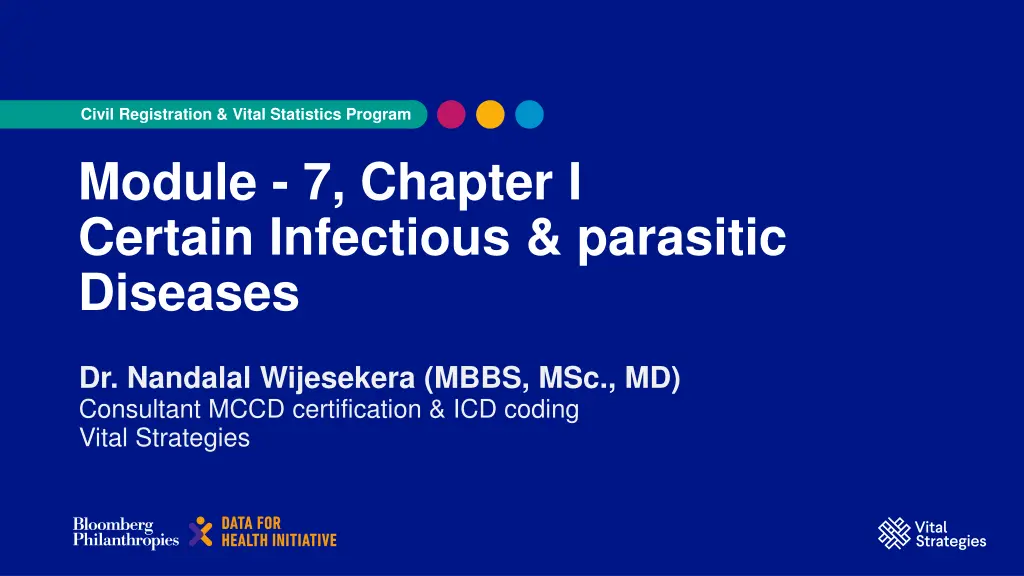
Key Points on Infectious and Parasitic Diseases in Civil Registration Program
Discover essential information on infectious and parasitic diseases in the Civil Registration & Vital Statistics Program Module 7, including categories, tuberculosis identification methods, coding examples, and more.
Download Presentation

Please find below an Image/Link to download the presentation.
The content on the website is provided AS IS for your information and personal use only. It may not be sold, licensed, or shared on other websites without obtaining consent from the author. If you encounter any issues during the download, it is possible that the publisher has removed the file from their server.
You are allowed to download the files provided on this website for personal or commercial use, subject to the condition that they are used lawfully. All files are the property of their respective owners.
The content on the website is provided AS IS for your information and personal use only. It may not be sold, licensed, or shared on other websites without obtaining consent from the author.
E N D
Presentation Transcript
Civil Registration & Vital Statistics Program Module - 7, Chapter I Certain Infectious & parasitic Diseases Dr. Nandalal Wijesekera (MBBS, MSc., MD) Consultant MCCD certification & ICD coding Vital Strategies
Module 7 Turn to Chapter I of volume 1 Page 142 work book
Important points for module 7 Categories range from A00 to B99 In fact, this is one of the largest chapters in ICD-10 171 of the 200 available categories have been used The chapter is divided into 21 blocks A00-A09 ------- ------- B99
Important points 7 Note the inclusion & exclusion notes (vol. 1) There are five exclusions & one inclusion listed at chapter level Presumption of infectious & noninfectious origin of diarrhoea; If presumed non-infectious, code to chapter - 11 If presumed infectious, code to this chapter - 1
Important points 7 Tuberculosis is identified by the method of confirmation.(e.g. sputum microscopy, CXR) A15 - Res. TB bacteri. / histologically confirmed - (vol. 1) A16 - Res. TB bac/ histologically not confirmed - (vol. 1) B20-B23 has a fourth character subcategory (vol. 1)
Important points 7 Block B50-B64 (vol. 1) provides guidance by the use of exclu. & inclu. notes on the action to be taken in mixed plasmodium infections B90-B94 (vol.1) are used for Sequelae
Few Examples Before Coding. 7 Ex; 1- Chronic Viral Hepatitis C Look up Hepatitis in index (vol. 3) Hepatitis - Viral - - Chronic - - - type - - - - C -> B18.2 Look up Vol. 1 for confirmation
More Examples Before Coding 7 Ex; 10 - Cytomegalovirus pancreatitis Look up pancreatitis in index (vol. 3) Pancreatitis - Cytomegaloviral -> B25.2 , K87.1* Look up Vol. 1 for confirmation
MoreExamples Before Coding 7 Ex; 18 - Sequelae of Leprosy Look up sequelae in index (vol. 3) Sequelae - Leprosy -> B92 Look up Vol. 1 for confirmation
Exercises - module 7 Few hints Exercises 3, 10, 13, 15, 20 has 2 codes & ex. 12 has 3 codes Oral - mouth Neonate explanation
Answers for module 7 1. B18.2 2. A50.2 3. B20.4, B37.0 4. J04.1 5. B72 6. P78.3 7. A15.3 8. L02.4 9. J02.0 10. B25.2 , K87.1*
Answers for module 7 11. B83.4 12. B21.0, C46.0, M9140/3 13. B65.1, B66.5 14. A75.0 15. A71.1 , H13.1* 16. B47.0 17. B71.0 18. B92 19. A00.0 20. B01.0 , G02.0 *
